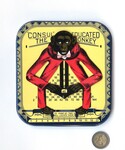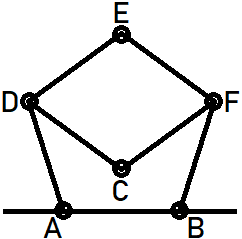
Consul, The Educated Monkey
Video
History
Mechanism
Simulation
Advertisements and articles
Patents
Links
Consul The Educated Monkey is a toy made of sheet metal. It depicts a monkey whose arms and legs are articulated in a clever way. There is a scale at the bottom going from 1 to 12 followed by a □ symbol, and the back plate has a triangular table of numbers. The monkey's feet can slide along that scale, and if the feet are on two numbers, the monkey's hands encircle their product in the table. The feet cannot both point at the same number, so if you want to square a number, put one foot on the number and the other on the □ symbol.
This version has a fold-out stand on the back so that it can be placed upright. It is a modern replica made by DBS, Düsseldorfer Blechspielwaren, and in one corner it has the year 2012. The front is very close to the 1916 original, except that the corners are a bit rounder.
I do not have any instructions. The original versions of Consul had an instruction card with the following text:
In order to slide the monkey feet along the slot very easily, be sure to use both of your thumbs, placing a thumb directly on each monkey foot and your middle fingers on the rivet heads underneath. (See back of plate.)
To multiply, adjust each of the monkey's feet to point directly at a number. The monkey's fingers will then locate the product of the two numbers, To multiply a number by itself set one foot to point at the number and the other at the □
To add, insert the addition card between the monkey and the plate and carefully locate it in proper position. Secure it to the plate by paper fasteners; or, if these are not at hand, the card can be neatly tied to the plate by passing a band of red twine through the card and through the small slots in the plate and tying in the rear. Further directions are on the back of addition card.
IT MAKES NO DIFFERENCE TO THE MONKEY WHETHER CHILDREN ARE BRIGHT OR STUPID, HE NEVER LOSES PATIENCE AT HAVING TO ANSWER THEIR QUESTIONS.
And on the reverse:
| MULTE | M-any U-seful L-essons T-aught E-njoyably | Brain power is increased by mental exercise. Turning work into play enables children to take the necessary exercise. The game Multe can be used to turn certain kinds of work into play. |
The mechanism of the Educated Monkey device is well adapted for use in playing games. It gives a chance to ingenious persons to invent a variety of games. It offers teachers an opportunity to develop a fine art in teaching children numerical tables and stimulating even the dullest to do their best.
The game Multe is played as follows: Several slips of paper are ruled, as shown below, should be prepared. In each of the upper ten spaces there should be written a pair of numbers each number being not greated than 12. The slips are placed in a hat or box.
Each contestant draws out a slip and select a product for each pair of numbers, and writes his selection on the slip, one product under each pair of numbers. In making these selections, beginners may be allowed to look at the monkey chart, but not to operate the monkey. When finished, each slip may be considered as ten questions and ten answers.
An umpire is selected by the players. The umpire takes a finished slip and calls out the first question and its answer. Each player who is in doubt as to whether the answer is correct is allowed to consult his monkey. If the answer is correct, the next answer is checked.
Whenever an incorrect answer is found the umpire cuts with scissors one space from the end of that portion of the slip which has already been checked. At the end of the game the player having the longest slip remaining is declared the winner of the game.
If each player saves their used slips and pastes them together end to end, then after a certain number of games, the contestant with the longest roll of slips is declared champion, for the day, or the week, as the case may be.
If this game is played by a class at school, the class should be divided into groups, the members of which are about equally matched in order that no one may become discouraged.
Beginners who know nothing of the table should be told to select their products at random, Enough slips to last for several games can be prepared in advance. Sample slip is shown here.
| 5x7 | 8x3 | 2x1 | 4x3 | 11x8 | 7x3 | 4x8 | 6x9 | 5x4 | 12x3 | For pasting ends |
It also came with a smaller card with an addition table.
| | ← | ADDITION TABLE | → | |
Push stem of a T-shaped paper fastener through here and through corresponding slots in plate, or fasten to plate by passing a band of red twine through card and slots and tying in rear.
| 2 | ||||||||||||||||||||||
| 13 | 4 | |||||||||||||||||||||
| 12 | 14 | 6 | ||||||||||||||||||||
| 11 | 13 | 15 | 8 | |||||||||||||||||||
| 10 | 12 | 14 | 16 | 10 | ||||||||||||||||||
| 9 | 11 | 13 | 15 | 17 | 12 | |||||||||||||||||
| 8 | 10 | 12 | 14 | 16 | 18 | 14 | ||||||||||||||||
| 7 | 9 | 11 | 13 | 15 | 17 | 19 | 16 | |||||||||||||||
| 6 | 8 | 10 | 12 | 14 | 16 | 18 | 20 | 18 | ||||||||||||||
| 5 | 7 | 9 | 11 | 13 | 15 | 17 | 19 | 21 | 20 | |||||||||||||
| 4 | 6 | 8 | 10 | 12 | 14 | 16 | 18 | 20 | 22 | 22 | ||||||||||||
| 3 | 5 | 7 | 9 | 11 | 13 | 15 | 17 | 19 | 21 | 23 | 24 |
And on the reverse is an extra set of directions:
TO MULTIPLY: See directions on the folder.
TO DIVIDE: Adjust the monkey so that one foot points at divisor
and the fingers point at the dividend. The other foot will be found
pointing at the quotient.
TO FACTOR: Make fingers point at a product, the feet will point
out, its factors.
TO ADD: Insert the addition table under monkey and secure in
proper position. Then proceed the same as directed for multiplication.
The monkey fingers will point out sum of two numbers instead
of their product.
TO SUBTRACT: Adjust the monkey so that one foot points at the
subtrahend and the fingers point at the minuend. The other foot will
be found pointing at the difference.
NOTE: If the feet stick at any point, do not force their movement,
but loosen by moving the arms.
 |
PUZZLE The diagram represents lines connecting
the pivot points of the monkey. The angles
ADE and EFB are equal and constant, and
the lines DE, DC, DA, FE, FC and FB are
equal to each other in length. Prove geomet-
rically that when the point A is held station-
ary and the point B moved along a fixed line
AB, the path of the point C is a straight line.
Determine its direction. |
Here is a video where I demonstrate the Consul, The Educated Monkey.
The Consul consists of a clever linkage. Each leg forms a single piece with the upper arm on the same side. It has three pivot points - at the foot, at the bow tie, and the elbow. The forearm pieces are connected together and to the elbow pivots. An important aspect is that the distances from the elbow to the other pivots are all equal. In the diagram below it means that BA, BC, and BF are the same length, as are DE, DC, and DF on the other side.
I will ignore the vertical sliding rod which only serves to provide a consistent window into the table, and to keep the Consul's head upright.
The angles marked α (BAC, ACB, CED, and DCE) are constant, but the angles marked β (CAE and AEC) vary depending on the location of the Consul's feet. Using isosceles triangles and the rhombus BFDC you can chase around the angles in the figure, as shown in the next diagram.
The result is that the constant angle α can also be found at FAE and AEF, making the triangle AEF similar to the triangle formed by the leg pieces. There are also other isosceles triangles with base angle β.
The constant angle α is 45° in the original Consul, but the proof works for any angle. When you move only one foot, the pointer F moves in a straight line diagonally at angle ±α. This heavily relies on the linkages being the same lengths, and if any parts differed in length, the movement would be curved, and the multiplication table would become distorted.
In the late 19th, early 20th century there were many performing monkeys in shows around the world. They were usually chimps, dressed up in a suit, and doing various human-like activities. The most famous one was called Consul, though actually there were a succession of chimps by that name. Whenever the current Consul died, the insurance policy paid out and a replacement Consul was soon trained. In 1909 Consul travelled from England to the USA to tour there. A film was made of his ocean trip, "Consul Crosses the Atlantic", which was exhibited across the country for several years.
On September 23rd 1910, Consul made a visit to the factory of NCR, National Cash Register in Dayton Ohio. In 1915 William Henry Robertson designed and patented the mathematical toy that bears the Consul name. Robertson worked at NCR, and although he joined the company shortly after Consul's visit, he had probably heard about it or seen the publicity photos.
William Robertson cofounded a new company, the Educational Novelty Company, also in Dayton, Ohio. At some point its main office was in Springfield, Mass., though the mmanufacturing remained in Dayton. In 1920 the office moved back to Dayton, and they relocated to larger premises. At the same time the company seems to have changed its name to the Educational Toy Manufacturing Company. It probably did not last very long, as in 1924 the Consul was being made by the Tepp Manufacturing Company of Detroit, Michigan, and Robertson was working for NCR as before.
You can try out the Consul in the simulation below, or to play it full screen open this simulation in a separate window.
Here are a selection of articles about various performing monkeys, mostly named Consul, from 1896 to 1925.
I found a few adverts for the toy, and some short articles about the manufacturing company.
Robertson filed two patent applications, first as a calculating device, and then as an educational monkey toy. The latter was granted first. In Britain a certain Charles Allaun patented it and manufactered a version named Jacko.
| Patent | Filing date | Priority date | Name | Description |
|---|---|---|---|---|
| US 1,188,490 | 03-09-1915 | 27-06-1916 | William Henry Robertson / The Educational Novelty Company | Educated Monkey toy |
| US 1,286,112 | 19-03-1915 | 26-11-1918 | William Henry Robertson / The Educational Novelty Company | Calculating device |
| GB 120,985 | 30-11-1917 | 02-12-1918 | Charles Allaun | Educated Monkey toy |
© Copyright 2023 Jaap Scherphuis, mechcalc a t jaapsch d o t net.